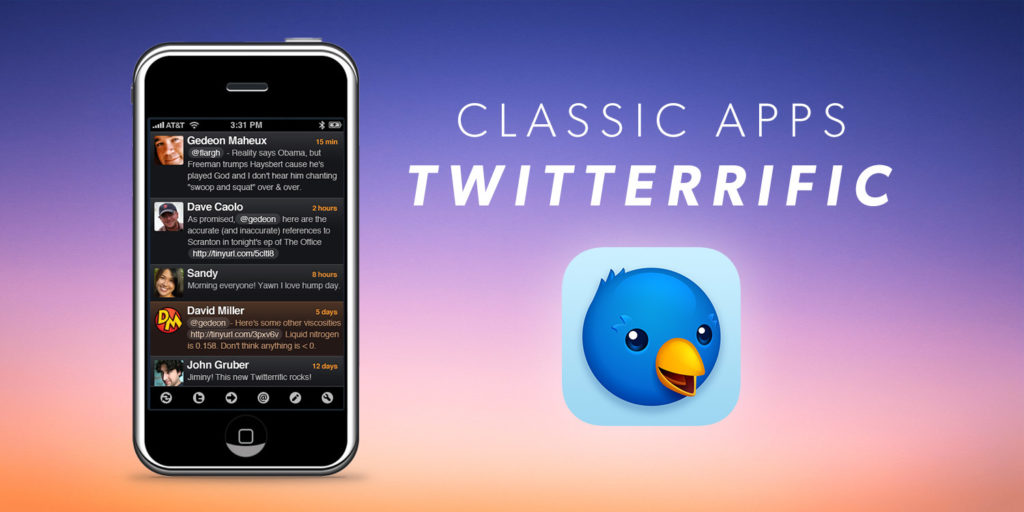The Twitter client that initially called updates a load of twits
Some apps are fleeting. Others are core parts of the iPhone’s history. In the first part of a series on classic apps, we dig into a Twitter client that shook up a fledgling social network.
What was Twitterrific?
Twitter launched in July 2006, primarily as a way for geeks to broadcast status updates. Compared to today’s Twitter, the service back then was bereft of features, and it could only be used in a browser.
Twitterrific in its very early days.
Twitterrific’s creators, Iconfactory, reasoned Twitter would make more sense on a desktop, and so created a client for Mac, which launched at the beginning of 2007. When Apple announced it would allow third-party apps for its smartphone, Twitterrific for iPhone was ready for the App Store’s launch, on July 10, 2008.
Why was it a classic?
Had Iconfactory built a bare-bones Twitter client, it wouldn’t have made an impact nor stuck in the memory. Instead, the team thought carefully about how to improve the user experience – and how best to make the app an ideal fit for iPhone.
On the Mac, Twitterrific even informed and influenced the brand and features of Twitter itself. It was the first to use a bird icon and support a character counter, replies and conversations. Along with Twitter, Iconfactory devised the word ‘tweet’ for updates.
On iPhone, there was great emphasis on speed, finger-friendly navigation, and visual design that instantly let you spot different kinds of tweets. This combination of innovation and attention to detail never let up.
Where is it now?
Very few Twitter clients from the early days remain. In fact, few apps of any kind from 2008 are still available. Twitterrific is an exception. Having weathered various storms, it’s now up to version 6.
Themes and settings let you tweak Twitterrific for your own personal needs.
Twitterrific continues to innovate and figure out what’s best for the people who use Twitter, doubling down on a chronological and ad-free timeline, enabling tweet edits, and including a raft of style and accessibility options to help you make Twitter your own.
Update: Twitterrific has been removed from the App Store after Twitter without warning pulled access to its service, after claiming Twitter clients broke long-standing rules that were only added to the terms days after that statement was made. We wish we were joking.
Visit the Twitterrific website.
Q&A: a brief history of Twitterrific
We speak to Iconfactory co-founder Gedeon Maheux about the birth of Twitterrific and the secret of its success.
What were you trying to achieve with the iPhone version of Twitterrific?
Gedeon: We primarily wanted a way to post to Twitter while we were on the go. Our native client for Mac, designed by Iconfactory principal Craig Hockenberry, was already a far better way to read and post to Twitter than the website. We knew having the ability to post updates from our pockets would be killer. It really upped the ante and was a ton of fun.
Do you have a particular high point from the app’s early years?
One was our early relationship with Twitter. Its team was eager to help the service grow and so forged a close relationship with developers like us. Several features we incorporated into our app made their way to Twitter in one form or another, thanks to that communication.
Our 2008 Apple Design Award was another high point. It’s also been surreal to see Twitterrific highlighted by Apple in various events over the years – even if for just a few seconds!
Apple exec Phil Schiller on stage at an Apple event, with Twitterrific on display behind him.
What have been the pros and cons of working on a third-party client?
Early on, we got to contribute to the foundation of Twitter itself. We were honored to have a small hand in helping shape the service everyone knows and uses today. The flip side was being tied to this same service.
Twitter for years attempted to limit third-party developers, locking us out from the full set of feature APIs, which the company reserved for itself. Those were frustrating times, but, thankfully, Twitter has reversed course and is now more open to working with developers again. There are still hurdles to overcome but overall we’re very happy with where things are headed.
What’s the secret to your app’s longevity?
Being blessed with loyal users that see advantages in using a third party client is one aspect. That’s helped us persevere rather than give up – so many others had to because of Twitter’s restrictions or due to lacking a large enough base of users to generate revenue.
We’ve also done our best to be fair with users about pricing and keep our app’s features updated – something that has been very challenging for such a small team over the years. Twitterrific is a labor of love for all of us at Iconfactory. Perhaps, in the end, that’s its greatest strength.
